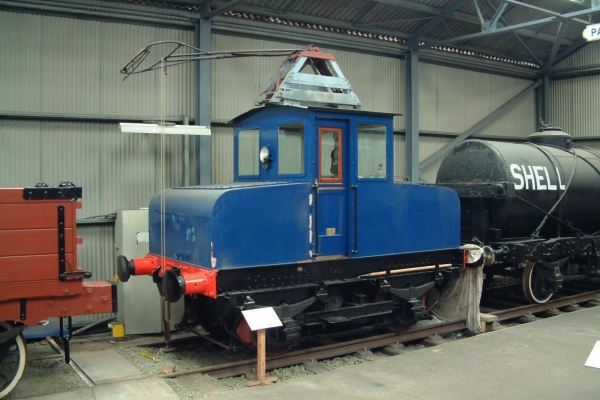


This locomotive used the Govan Road tram tracks to haul wagons from Govan Goods Yard to Fairfield's shipyard. Immediately to the east, Harland & Wolff's yard used a battery electric locomotive for the same purpose, while a little to the west Alexander Stephens shipyard used the tram tracks and a railway connection from Shieldhall Goods Yard, and had a variety of steam, battery and diesel traction.
Railway wheels have broader treads than tramway ones, and as a result a standard gauge (4 feet 8½ inches or 1435mm) railway wheelset has a smaller back-to-back dimension than a standard gauge tramway wheelset. While a standard gauge tram will run on a standard gauge railway track, the reverse is not the case because the tramway railheads incorporate flangeways, which are too far apart for railway wheels. Hence railway wagons cannot use standard gauge tramway tracks. To overcome this, all the Glasgow tramways were built, from their inception in horse car days, to a gauge of 4 feet 7¾ inches (1416mm), and so could pass railway wheels which would run in the railhead flangeways. This enabled the shipyards to use the tram lines for goods access.
The last trams ran on Govan Road in 1958, but trolley buses took their place, and Fairfields converted their locomotive from bow collector to trolley pole pick-up. Dedicated trolley wires were provided, installed midway between those of the trolley buses, possibly to allow overtaking. Fairfield's railway traffic ceased in September 1966, and the locomotive was donated to SRPS. For display at Bo'ness, a long reach bow collector has been fitted, as carried by the locomotive from 1940 to 1958.
This is an example of the English Electric Company's Type 3B electric locomotive, of which at least 35 were built for the home market between 1920 and 1951, the majority at the former Dick Kerr works at Preston, where the company's traction department was located. These locomotives could be supplied battery powered or equipped for overhead power collection. All had a centre cab, and sloping-top compartments at each end. When constructed as a battery locomotive, these could be extended as required to accommodate the batteries. Differing motors could be fitted, depending on the intended duty, and the Fairfield example has two axle-suspended EE505 motors each rated at 75 HP. The locomotive has a handbrake, rheostatic braking and, unusually, a tramway-type magnetic track brake for emergency use.
Design information from C. Shepherd, English Electric Battery Locomotives, "Industrial Railway Record", June 2007.